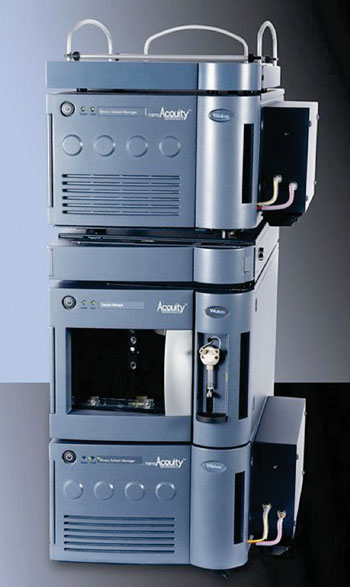Protein Saliva Test Diagnoses Autism
By LabMedica International staff writers
Posted on 12 Feb 2015
Autism spectrum disorder (ASD) currently affects one in 68 US children, and the number of people diagnosed with autism continues to rise, and diagnosis is currently made based on behavioral observations, but no biological test for autism exists.Posted on 12 Feb 2015
Recent developments in biochemistry technology could help facilitate study of ASD at the protein level, providing much-needed insights into causes and consequences and convergence of multiple genetic pathways to affect a few common protein biomarkers has been proposed.

Image: The nanoACQUITY Ultra Performance Liquid Chromatography (UPLC) System (Photo courtesy of Waters).
Scientists at Clarkson University (Potsdam, NY, USA) collected human saliva samples at a neuropsychology clinic and participant identities were unknown to the investigators conducting the study. Participants, ages 5 to 17, either had ASD diagnosed or were control subjects without any ASD diagnosis or diagnosis of any other neurodevelopmental, psychiatric, or major medical condition. Saliva samples from six donors were analyzed twofold. In the first case, six individual saliva samples from six donors were pooled in one ASD sample (ASD pooled sample) and the same was done with the six control samples.
The samples were analyzed by a nanoliquid chromatography-tandem mass spectrometer (nanoLC-MS/MS) using a NanoAcquity UPLC (Waters Corp.; Milford, MA, USA) coupled to a Waters’ quadrupole-time-of-flight (QTOF) Micro MS through a 20 µm ID picotip emitter (New Objective, Woburn, MA, USA). Quantitation of differentially regulated proteins within each individual ASD and control samples was performed in two ways: precursor ion intensity and spectral counting.
The team found statistically significant differences in several salivary proteins, including elevated prolactin-inducible protein, lactotransferrin, immunoglobulin (Ig) kappa chain C region, Ig gamma-1 chain C region, Ig lambda-2 chain C regions, neutrophil elastase, polymeric immunoglobulin receptor and deleted in malignant brain tumors 1. The proteins identified primarily have functions in immune system responses, or are elevated in people with gastrointestinal problems. The group also reported that several of the identified proteins interact with one another.
Costel C. Darie, PhD, a co-lead author and proteomics expert said, “We are the first in the world who proposed a protein complex as a potential biomarker signature, which gives us information not only about the proteins, their relative quantities and their modifications, but also about their interactions with other proteins.” The work is promising for the eventual development of an autism diagnostic test although more subjects need to be studied to confirm that the markers are consistently different in people with autism. The study was published on January 27, 2015, in the journal Autism Research.
Related Links:
Clarkson University
Waters Corp.
New Objective












.jpg)
